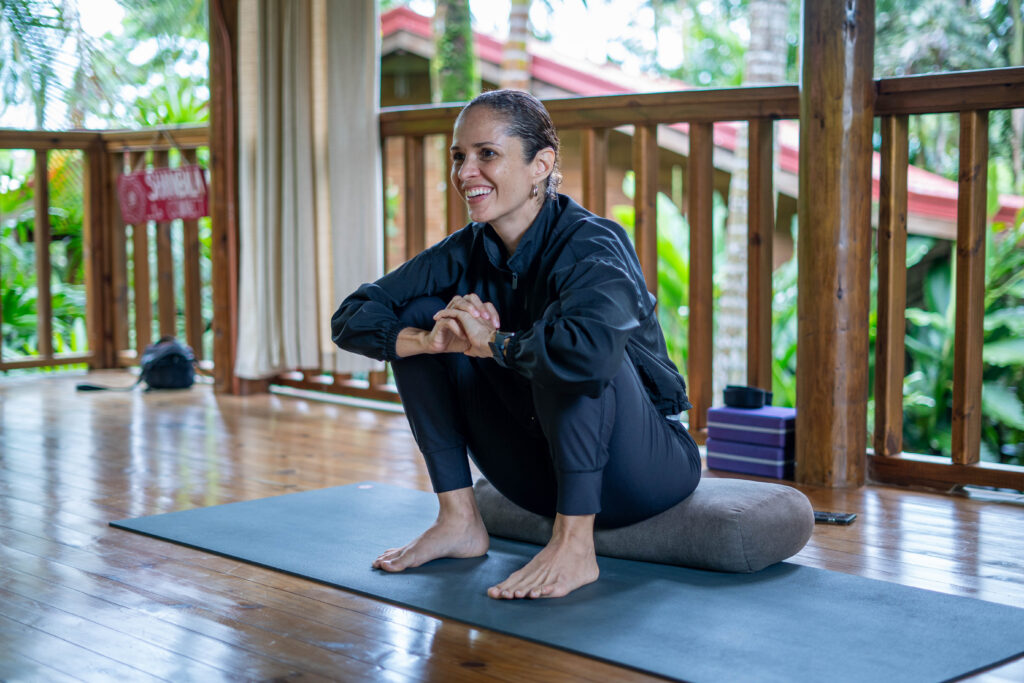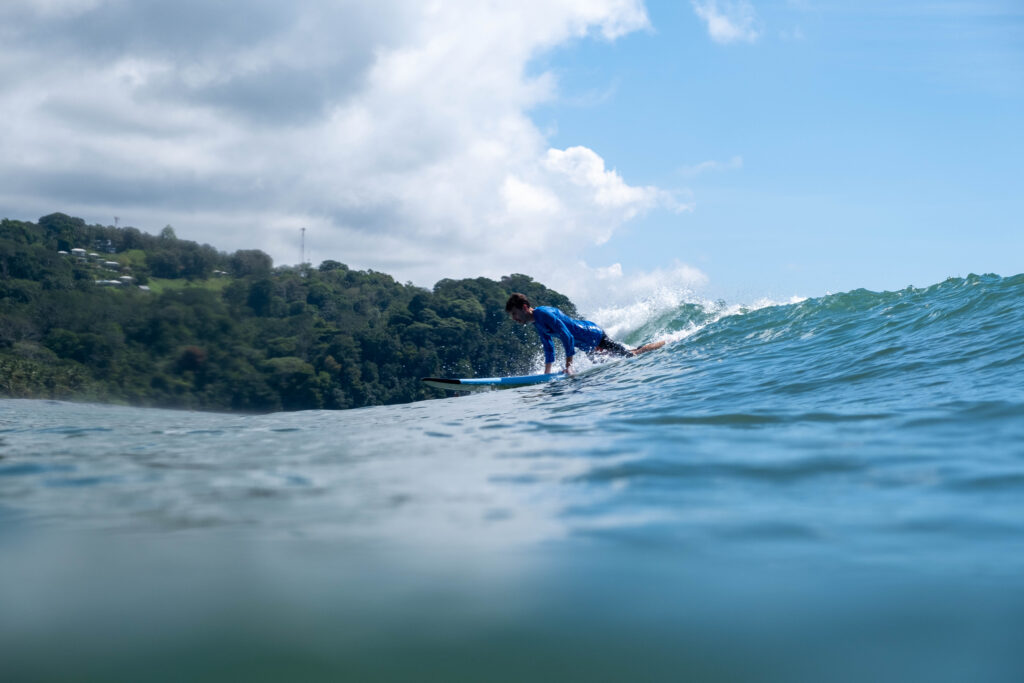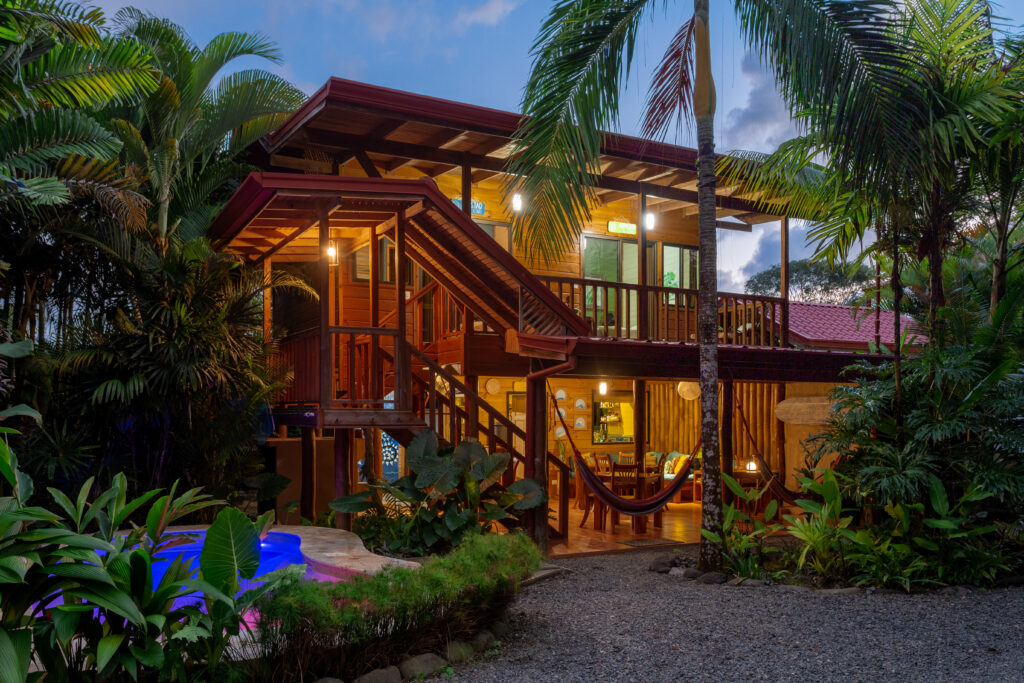Everything You Need to Know About Bodysurfing
“To me, bodysurfing is the best interaction between man and nature that exists.” – Mike Stewart.
Bodysurfing is an elusive activity about which only a little information is widely known or disseminated to the masses.
Most ocean people—surfers, coastal dwellers, fishermen—understand the importance of bodysurfing. To them, it may be more than just a pleasurable activity but rather a practical way to get from point A to B.
Yet, there is something mystical about the activity. Bodysurfing is the best way to connect with the ocean’s power, simply because, unlike board-surfing, nothing separates the bodysurfer from the wave.
In honor of our Bodhi Awaken: 14 Night Bodysurfing, Ocean Awareness, Surf, and Yoga Retreat, we have consolidated much of the existing bodysurfing knowledge and information into one handy guide.
We truly believe it is “everything you need to know about bodysurfing.” Of course, we hope you will join us on this retreat and put this knowledge into action!

7 Day Surf Camp
Week long, set-date, surf vacations that invite you to learn the art of surfing while learning about Mother Ocean, engaging with the community, and awakening the inner surfer.
Learn MoreHistory of Bodysurfing
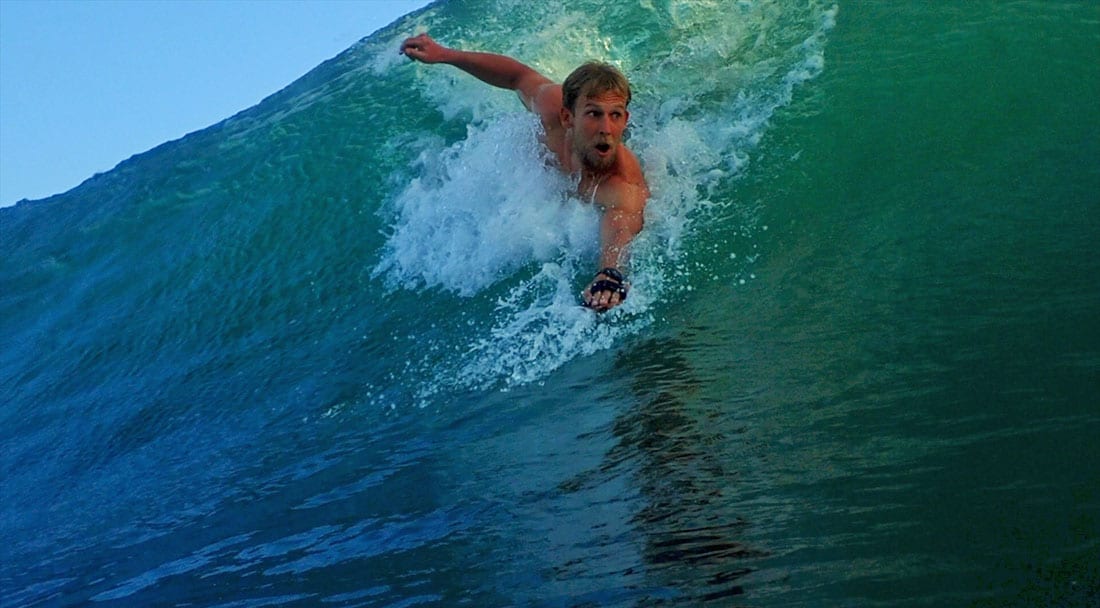
Disclaimer: the majority of the following information is paraphrased from Matt Warshaw’s Encyclopedia of Surfing online database.
“Hawaiians showed me that it’s not always about the biggest wave or a huge barrel. It’s about being in the ocean and having fun.” – Mark Cunningham
There isn’t much known about the history of bodysurfing, at least in comparison to that of board surfing, which was first recorded by crew members of Captain Cook’s 1778 expedition through the Pacific Islands of Tahiti and Hawaii (although surfing was likely established long before recorded history, maybe even as early as 2000 BC).
According to Matt Warshaw, author of the Encyclopedia of Surfing, “Nothing factual is known about the origins of bodysurfing, but it’s possible that humans were inspired to emulate wave-riding sea animals such as dolphins and seals,” and that “bodysurfing certainly predates board-surfing.”
Considering the surf leash wasn’t invented until the early 1970s, it is fair to assume that anyone who surfed before that time must have also known how to bodysurf or at least known how to swim sufficiently through the surf zone to retrieve a lost board.
Read More: The Untold History of Surfing.
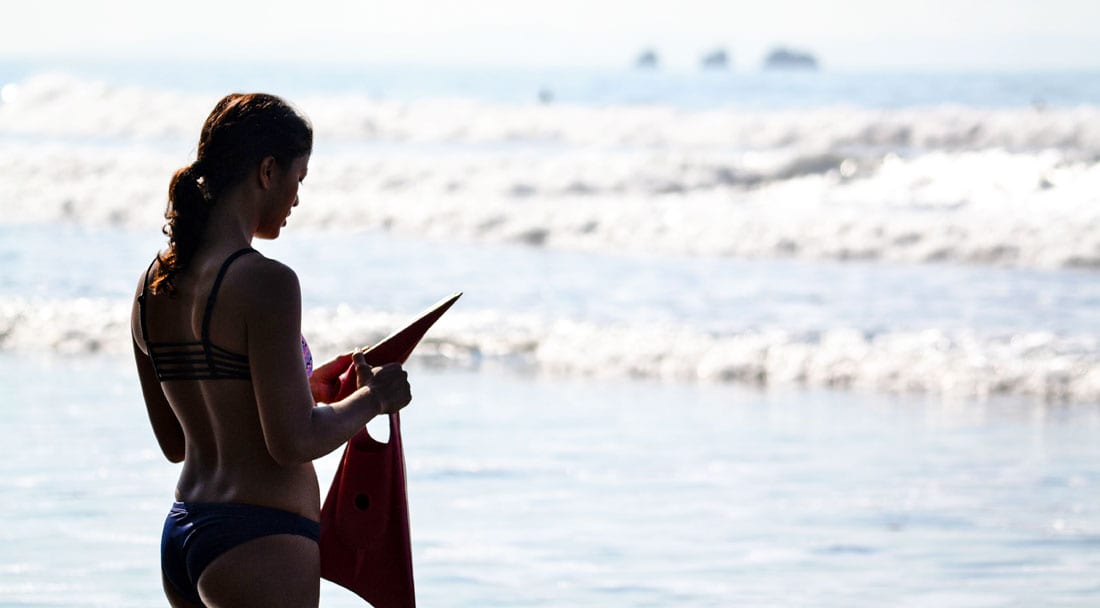
The Art of Wave Riding
Bodysurfing existed under the radar for a period, but one of the earliest attempts to legitimize bodysurfing came from California lifeguard Ron Drummond, who published the first-ever book on bodysurfing (and surfing in general) in 1931.
Drummond’s intention for writing The Art of Wave Riding was to bring about a bodysurfing renaissance.
“Wave riding — without a surfboard — is a sport with which few people are familiar, and it is undoubtedly in its initial stages of development,” Drummond wrote.
“There are no books of instruction on the subject, and at present, only a few of the more athletically inclined have become proficient wave riders.” Drummond goes on to comment on the necessity for such an instructional book:
One has only to watch a swarm of bathers at any crowded beach to see that thousands of people are interested in the sport.
Whenever a good wave for riding comes in, about half the people attempt to ride it, and only about one-tenth of one percent of them even get started on it. It is this pitiful sight of thousands of swimmers, young and old, men and women, always trying and never succeeding, that has urged me to put into print a few hints that I hope will be of some help in teaching the enthusiastic beach-goers the art of body surfing, and thus increase a thousand fold the pleasure derived from ocean bathing.
The biggest leap forward in the sport of bodysurfing, however, came not from Drummond’s how-to manual but from the invention of “Duck Feet” swim fins by California surfer Owen Churchill in 1940. Churchill came up with the idea for swim fins after observing Tahitian bodysurfers use “soft rubber and metal bands shaped like a fish tail” to generate more power when kicking into waves.
It was around this time that bodysurfers began lengthening their rides by surfing horizontally (angling right or left) across the breaking wave face, as opposed to riding already-broken whitewater waves straight to shore.
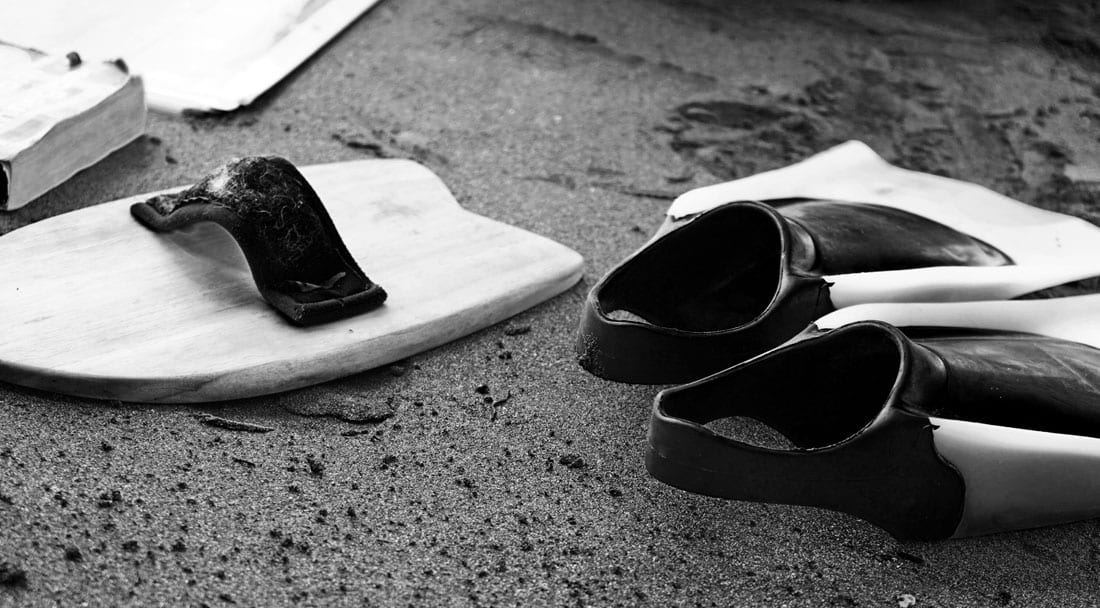
Bodysurf Equipment: What Do You Need?
“There are no phonies in bodysurfing. There is no glory in carrying a pair of fins. It’s a basic, primitive thing. It’s just you and the ocean.” – Robert Gardiner
One of the best things about bodysurfing is that it requires very few pieces of equipment. According to Rick Lomax of SurfScience, the production of surfboards alone emits an average of 220,000 tonnes of CO₂ per year into the Earth’s ever-warming atmosphere.
If we take into account the surf industry’s prevailing supply chain — chemical resins, polystyrene foams, petroleum-based wetsuits — the industry is arguably creating more environmental harm than good.
Thus, bodysurfing represents a shift toward a more environmentally responsible version of wave riding.
Other than wearing a bathing suit that creates minimal drag (Mark Cunningham suggests wearing a Speedo), a good pair of swim fins is the only piece of equipment a bodysurfer really needs.
As previously mentioned, the advent of swim fins by Owen Churchill in the 1940s drastically improved the ability of bodysurfers to catch and ride waves. They provide some resistance to the bodysurfer to reduce the chances of breaking the surface tension of the water.
Although Churchill Swimfins remain the top-selling swim fin in the world to this day, they are primarily used by bodyboarders and, to a lesser extent, by bodysurfers.

Best Swim Fins for Bodysurfing
When looking for a pair of swim fins, it is important to try them on first to make sure they are comfortable. We recommend keeping them on for a few minutes, as some fins may seem fine, but they’re actually too tight. This tightness will start to manifest a few minutes into wearing them.
Some bodysurfers like stiff fins with a big blade that will generate a lot of kicking power, while others prefer a lighter fin with a more comfortable shoe pocket. There’s no right or wrong; you choose what feels more comfortable to you.
The majority of ocean lifeguards (many of whom are also bodysurfers) wear swim fins made by DaFin, a company based out of Hawaii.
Mark Cunningham, who has his own DaFin model, has been using their fins for over two decades, along with some of the best watermen and women in the world.
Other good swim fin options include:
But if you are former world champion surfer Dave Rastovich, you don’t even necessarily need the fins.
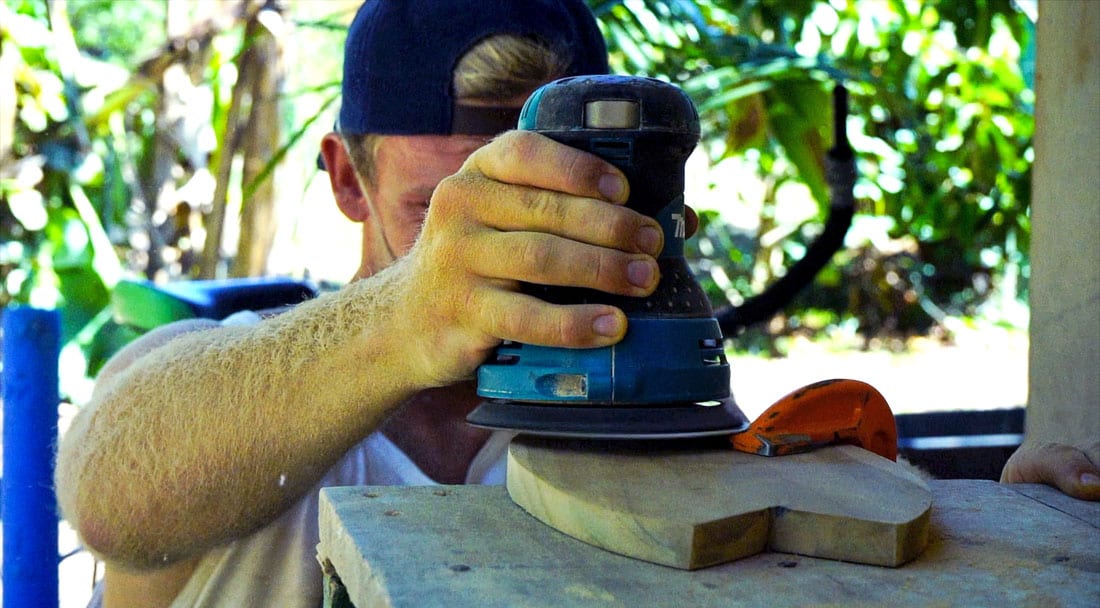
Best Bodysurf Handplane
A bodysurfing hand plane is another piece of equipment often adorned by bodysurfers, although not essential to the sport.
A handplane is essentially a small board that is worn on the lead hand of the bodysurfer to help her trim the face of the wave and hold a line. The handboard also helps the bodysurfer get into the wave earlier and stay on the wave longer.
However, the major downside to wearing a hand plane is that the bodysurfer has to swim through the ocean wearing a weighted object on their hand, which results in less freedom of expression/maneuverability when riding waves.
For more information on when to use a handplane, read through this article published by The Inertia.
That being said, one of the exciting aspects of using a handplane is that you can easily make one for yourself out of repurposed materials.
If you already own a jigsaw and random orbit sander, then all you need to find is a thin piece of plywood (teak and balsa are both good options), and a piece of rubber or neoprene to fashion a hand strap. Check out this video for more information on how to build your bodysurfing handplane.
However, if you prefer to save yourself some time and purchase a handplane, then look no further than Enjoy Handplanes based out of Leucadia, California.
Founded by up-cyclers Ed Lewis and Kipp Denslow, “All Enjoy Handplanes are made with either old foam from broken boards or ruined blanks from manufacturing for the board and neoprene from used wetsuits to make the handles.”

Another one of our favorite bodysurf handplane brands is Wave After Wave (WAW) Handplanes, based in Sydney, Australia.
WAW Handplanes is a 1% for the Planet member that makes high-performance bodysurfing handplanes out of recycled marine plastics and responsibly harvested timber.
The WAW Badfish Bodysurfing Handplane is made from 100% post-consumer recycled plastics—much of which is collected from the waters surrounding Australia’s Great Barrier Reef—resulting in over 10,000 kg of plastic recycled to date.
In recognition of its innovation and resulting supply chain, WAW’s Badfish handplane received the “Make Good – Defy Plastic” award from National Geographic in 2019.
Since 2016, WAW Handplanes has committed to planting one tree for every WAW Timber Fish Bodysurfing Handplane sold. In collaboration with Carbon Positive Australia, WAW Handplanes has planted over 7,000 native trees to date.
Other good bodysurf handplane options include:
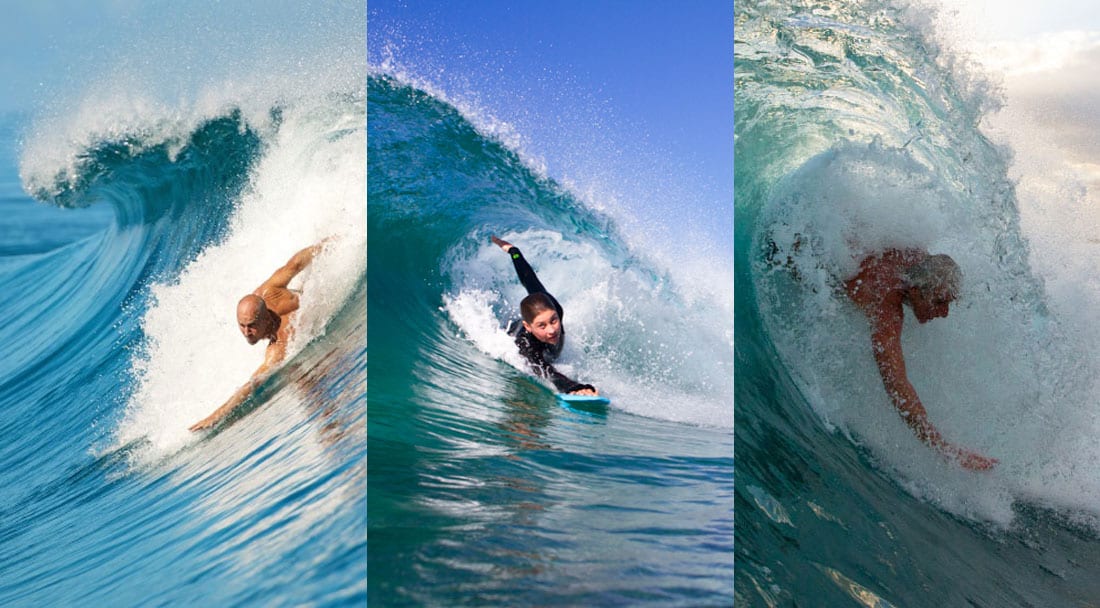
Notable Bodysurfers
Here are some honorable mentions of bodysurfers that we had to include:
1. Richard Keaulana
One of the first well-known bodysurfers to progress the sport was Richard “Buffalo” Keaulana, a skilled Hawaiian surfer and lifeguard on Oahu’s west side. He held his lifeguarding post at Makaha Beach from 1969 to 1995.
Keaulana, whose wave-riding style was akin to that of a seal, was considered by many to be the best bodysurfer of his era. This was likely due to thousands of hours spent in the water at Makaha.
Buffalo’s son, Brian Keaulana, is a renowned waterman and ocean safety expert who helped design the DaFin swim fin.
2. Mark Cunningham
The next bodysurfer to make a name for himself by perfecting his craft was Mark Cunningham, who served 29 years as a lifeguard on Oahu’s north shore and was one of the first bodysurfers to pioneer waves at the Banzai Pipeline.
Cunningham was widely considered the best bodysurfer in the world from the 1970s through the 1990s and remains the sport’s most notable figure.
During his competitive tenure, Cunningham won the Pipeline Bodysurfing Classic — the premiere bodysurfing contest in the world — at least four times. (Record-keeping for this contest began in 1981).
3. Mike Stewart
Today, the best bodysurfer in the world is undoubtedly Mike Stewart, who is also a nine-time world bodyboarding champion.
Stewart is widely considered the best wave rider in the world due to his numerous championships in bodysurfing and bodyboarding.
Both Stewart and Cunningham were featured in a 2011 film on bodysurfing titled Come Hell or High Water, produced by former professional surfers Keith and Dan Malloy.
The film includes footage of Stewart and Cunningham bodysurfing near-perfect waves at Teahupo’o — a rarely bodysurfable wave in Tahiti, and undoubtedly one of the most dangerous waves in the world.
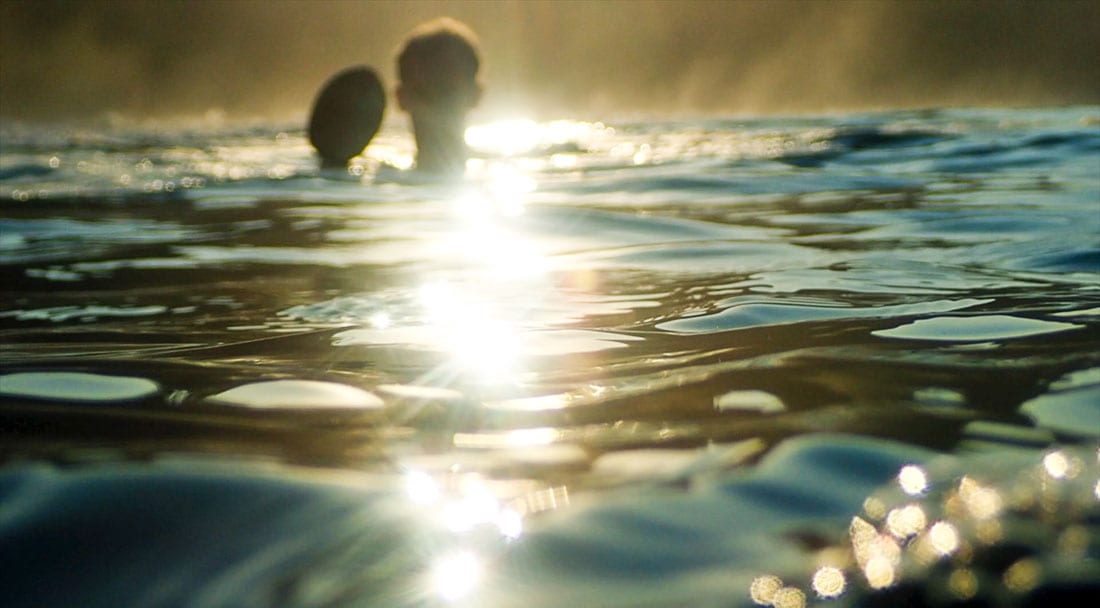
Connecting with Mother Ocean
“It simply feels good. I get exercise, I get to go outdoors, I see my friends, and I’m completely surrounded and immersed in nature.” – Mark Cunningham
Although the sport of bodysurfing has progressed tremendously over the past couple of decades, it remains the least publicized form of wave-riding to this day, primarily because it is the least marketable of all forms of surfing.
However, what the sport lacks in marketability, it makes up for in soulfulness. The simplicity of bodysurfing is exactly what makes it so valuable: less equipment results in fewer learning steps, more freedom, and a deeper connection with the wave and nature itself.
Considering that the human body has nearly the same density as water (which allows us to float) and that our mineral content is almost identical to that of the ocean, it makes sense that bodysurfing would “simply feel good” for most people.
What’s more, bodysurfing provides a tremendous full-body workout that results in an increased release of endorphins as you constantly either swim or kick your legs to stay afloat.
Bodysurfing is both aerobic and anaerobic, as it involves sustained physical effort over a long period and short bursts of energy at maximum effort, which can greatly benefit physical and mental health.
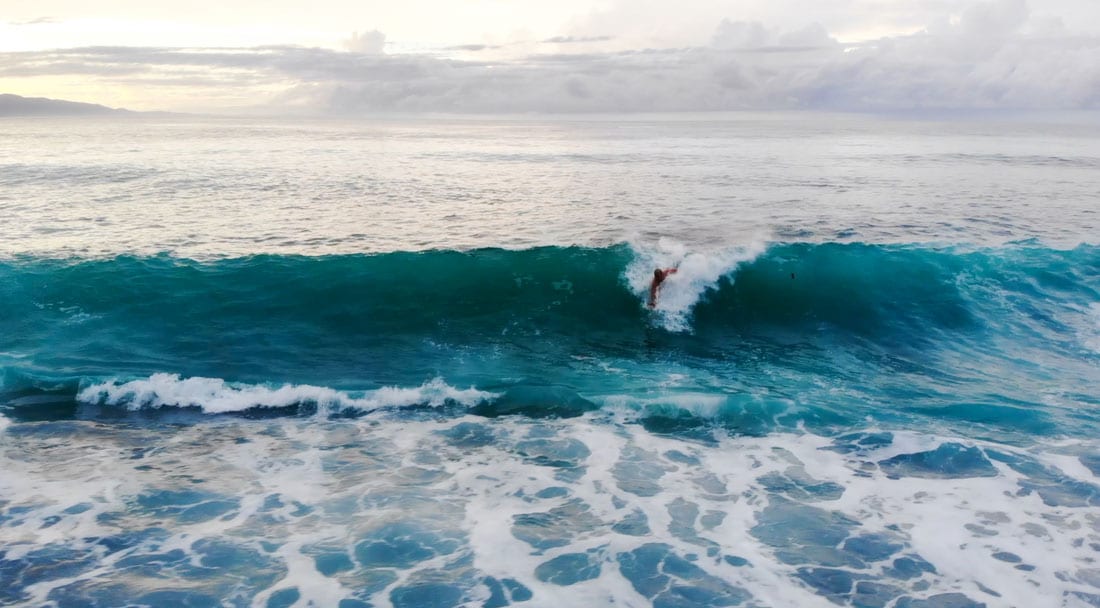
The Blue Mind Effect
In recent years, scientists around the world have been pushing to understand the positive effect nature exposure has on the human psyche.
In his best-selling book Blue Mind, marine biologist Wallace J. Nichols argues that being in and around water has therapeutic benefits that can make humans happier, healthier, and more connected.
Nichols claims that the average person in today’s society has to process more information daily than at any other time in history, which has resulted in unprecedented levels of anxiety and depression.
He believes that most people operate constantly in a reptilian fight or flight “Red Mind,” which can be counteracted by spending more time around water:
When you’re in the water, your brain is getting a break.
Getting to the water forces us to disconnect from the auditory and visual information stream. It switches our brain to the Blue Mind, which helps us relax and reconnect with nature, others, and ourselves.
There is a beautiful scene in Come Hell or High Water that features Don King — a renowned surf photographer and winner of the 1992 Pipeline Bodysurfing Classic — bodysurfing with his autistic son Beau.
Anyone who watches this scene can clearly see the ocean’s calming effect on Beau and how much he enjoys playing in the surf with his father.
“One of the neat things about Beau,” King says, “is how comfortable he is in the water and how much he likes it. And so, when I go in the water with Beau, for a while, I can just play with him and forget about all the problems of autism, and it’s just me and him.”
Learning to Bodysurf
“I’ve got basic bodysurfing tips: know how to swim, have a suit that’s gonna stay on, kick like hell, and come out of the water smiling.” – Mark Cunningham
For people who grew up near the ocean, especially in places like the Hawaiian islands (where youngsters practically live in the ocean), bodysurfing is completely self-taught.
Playing in the shore break leads to a natural progression of figuring out how to catch and ride waves without equipment before moving on to more complex versions of wave-riding, like bodyboarding and surfing.
Learning from the Expert
However, if you grew up, say, in the mountains, then you might not have the slightest idea how to bodysurf or even how to navigate the shorebreak.
Therefore, let’s take a look at what Ron Drummond, author of The Art of Wave Riding, had to say about bodysurfing for beginners back in the 1930s. For those looking to get into the sport, “A powerful stroke, speed, good endurance, and the absence of fear are the primary requisites.”
Drummond continues with a step-by-step approach to the basics of bodysurfing:
Walk out to a point where the waves are breaking deep between the knee and waist. The object is to fall with the wave as it curls over; therefore, the essential factor is to judge the time and place of this curling.
When ready for a start, turn your left side toward the shore and watch the approaching wave over your right shoulder.
When the wave is about to break on you, take a step toward the wave so you are falling or sinking into the base of the swell.
When catching the wave, give the body a strong swing forward and throw the arms straight out ahead with hands clasped together. Hold the body and legs quite rigidly.
But if you are more of a visual learner or simply looking for a less dated explanation of bodysurfing basics, then check out our explanatory video on the matter:
Bodysurfing vs Board-surfing
“I’ve occasionally had a bad time surfing, but I’ve never had a bad time bodysurfing.” -Mark Lukach
As Matt Warshaw points out in the Encyclopedia of Surfing, “Prior to the invention of the surf leash in the early 1970s, all surfers were adept bodysurfers, as nearly every wipeout was followed by a bodysurfing ride to the beach to pick up the lost board.”
For centuries, anyone who surfed — by way of necessity — also knew how to bodysurf, and for many a skilled water person, the two methods of wave-riding went hand in hand.
Not only does bodysurfing make you a stronger swimmer and a better breath-holder, but it can also provide you with the necessary foundation to become a proficient surfer.
Bodysurfing teaches the individual how to see waves, how to dive beneath them, how to catch them, how to move around other surfers, and how to identify rip currents and other potential hazards.
You can actually feel the water moving around you when bodysurfing, as opposed to simply observing it in the case of board-surfing, which helps you get in tune with the ocean.
Is Bodysurfing Easier Than Surfing?
The short answer is yes. Bodysurfing is easier than board-surfing. Here’s why:
- Equipment: Body surfing requires minimal equipment—usually just swim fins, whereas surfing necessitates a surfboard and sometimes a wetsuit, making it more complex.
- Learning Curve: The techniques for body surfing are simpler. It involves catching and riding waves using just the body, which can be more intuitive than balancing on a surfboard.
- Physical Requirements: Surfing requires greater balance, coordination, and strength to manage the board and execute maneuvers. On the other hand body surfing primarily relies on swimming skills and wave timing.
- Accessibility: Body surfing can be done in a wider range of wave conditions, including smaller and less powerful waves, making it more accessible to beginners.
Bodysurf First
In order to be a professional surfer, especially those taking on big waves, bodysurfing is a necessary and potentially life-saving skill to have.
Some of the best professional surfers in the world are also incredible bodysurfers — Dave Rastovich, Kelly Slater, Rob Machado, Greg Long, Belinda Baggs, the Malloy brothers, and so on.
Undoubtedly, these surfers find pleasure in bodysurfing merely because there is less pressure to perform when riding waves sans surfboard. For some, being immersed in the ocean simply feels better than sitting or standing on top of it.
In an interview with Surfline.com, Mark Cunningham describes why he prefers bodysurfing to board surfing: “It gives you a different feel. You’re in the wave, you’re a part of the wave, the wave’s energy is going through you.”
As Cunningham points out, it’s quite a special feeling to have nothing in between you and the wave, as your body receives ocean energy that has traveled hundreds of miles to be transmitted to and then through you.
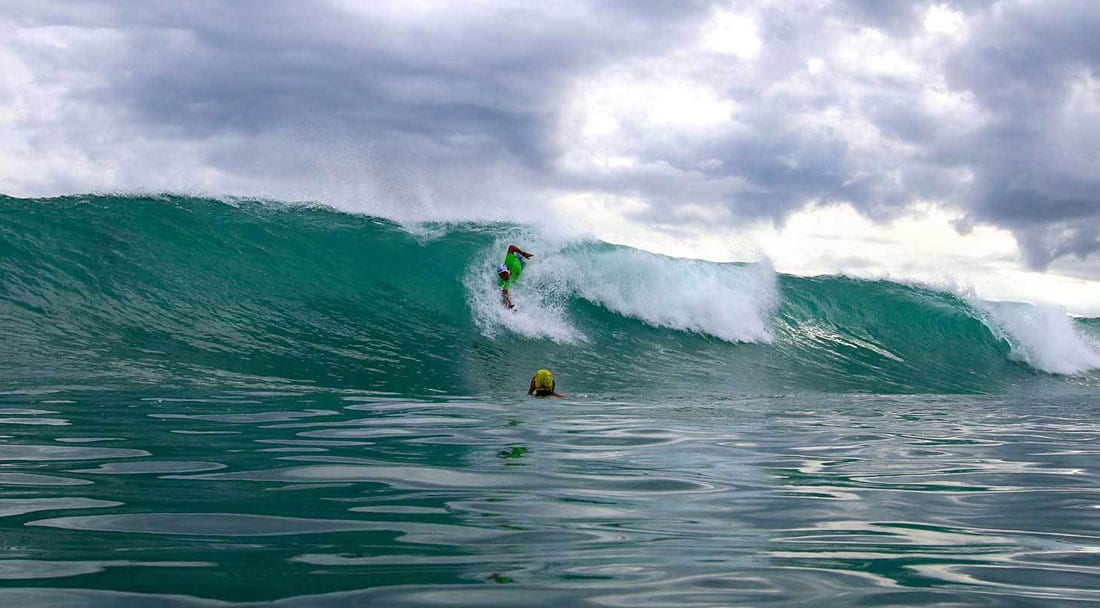
Photo c/o Jeff Cantrell
Where Can You Bodysurf?
“People around the world love swimming whether it’s in a pool, a lake, a pond, or in the ocean. It’s gone on for thousands of years, playing in the ocean energy.” – Mark Cunningham
One of the difficult aspects of bodysurfing, compared to board surfing, is that bodysurfers are partially submerged when riding waves and cannot create nearly as much speed as surfers because of the extra drag.
Thus, an excellent bodysurfing wave typically has a steep, “peaky” section that will provide the bodysurfer plenty of speed from the takeoff, but not so fast that the wave immediately overtakes the bodysurfer.
“You may not be able to make a real fast down-the-line wave,” says Keith Malloy, “so you are looking for a hollow, peaky, powerful nugget of a wave.”
While this may not appeal to speed lovers, it keeps you in the wave longer, allowing you to enjoy the experience more.
One of the best things about bodysurfing is that it is much easier to get barreled than when standing on a surfboard.
The bodysurfer becomes less concerned with the length of the ride and more focused on finding a steep drop that will result in a brief tube ride — the pinnacle of wave-riding.
“The beauty is that if it’s waist high, you can be getting totally barreled in the most critical part of the wave,” says Malloy, “where if you’re standing on a board, you probably won’t fit in there.”
Best Bodysurfing Beaches
Here are some of the best bodysurfing spots around the world for you to try:
1. Lagundri Bay, Indonesia
Lagundri palm-fringed bay offers peeling perfection and barrels of epic proportions. The waves here are so incredible that nothing you surf afterward will ever compare. Be prepared to take a beating at this remote Indonesian paradise.
2. Byron Bay, Australia
Byron Bay’s easterly position catches swell from all directions, making spots like The Wreck, The Pass, Cozy Corner, and Watego’s prime bodysurfing waves. The stunning scenery and laid-back vibes add to the appeal of this bodysurfer’s heaven.
3. Anchor Point, Morocco
This remote spot near the fishing town of Tarazhout offers uncrowded, world-class waves like Anchor Point, Boilers, and Killer Point. Between surf sessions, visitors can explore the desert and immerse themselves in the Berber culture.
4. The Wedge, California
Arguably California’s most infamous bodysurfing spot, The Wedge, demands respect with its powerful shore break. Taming this brutal wave is similar to riding a raging bull – get pitted or get crushed trying.
Note: The Wedge has instituted a “Blackball” rule that forces boards out of the water during peak summer months at certain times of the day.
5. Point Panic, Oahu
Point Panic is one of few waves in the world that is designated solely for bodysurfing (no boards allowed). Bodysurfers at Point Panic enjoy long rides in which they can stay in the wave pocket and perform acrobatic maneuvers like stalls and spins.
Bodysurfing Styles
The bodysurfing style is unique to the specific wave and how the wave breaks. For example, bodysurfers at Point Panic enjoy long rides in which they can stay in the wave pocket and perform acrobatic maneuvers like stalls and spins.
On the other hand, wedge bodysurfers take on steep drops in which they have to angle their body differently to make it down the hollow wave face.
Furthermore, the Wedge is a heavy shore break wave that breaks in very shallow water, so it helps to have a little more muscle to be able to absorb a pounding.
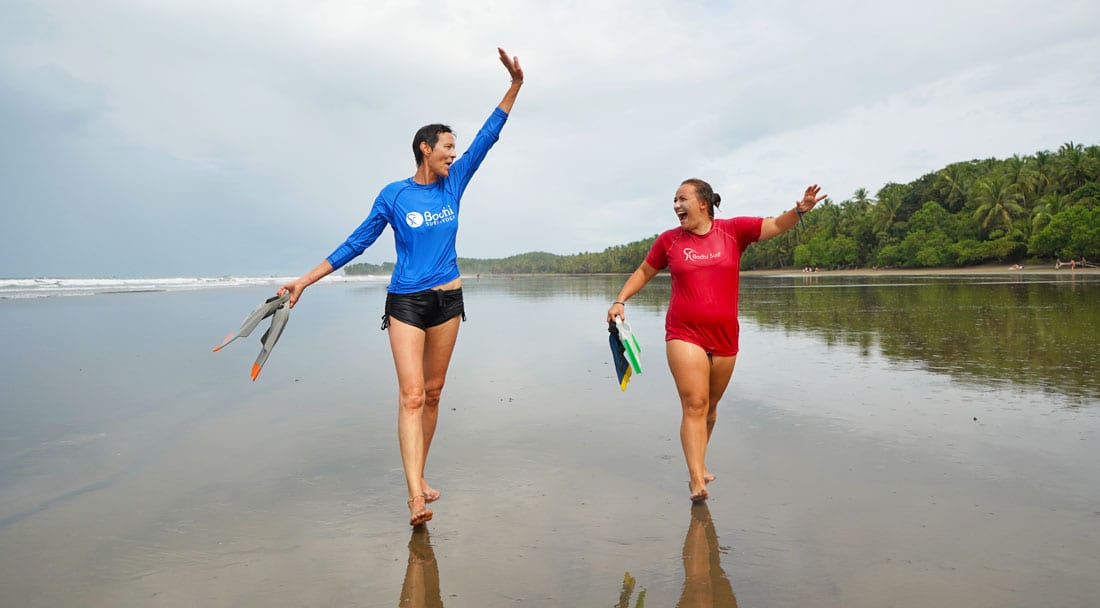
Bodhi Awaken: 14 Night Bodysurfing, Ocean Awareness, Surf and Yoga Retreat in Costa Rica
We are very excited to offer a two-week retreat that includes a beautiful combination of bodysurfing, surfing, and yoga.
As surfers and “fishpeople” ourselves, we understand the great value of imparting the skill set of bodysurfing before teaching how to surf.
Our foremost goal at Bodhi Surf + Yoga is to provide a holistic education. We believe that teaching bodysurfing and ocean awareness is key in forging surfers, lovers of the sea, and ultimately Ocean Guardians.
At present, no other retreat like this exists in the world, so we hope to attract people of all types, especially those who are scared or intimidated by the ocean (many people are in this boat) yet still feel drawn to it.
Read more details on this new retreat here.
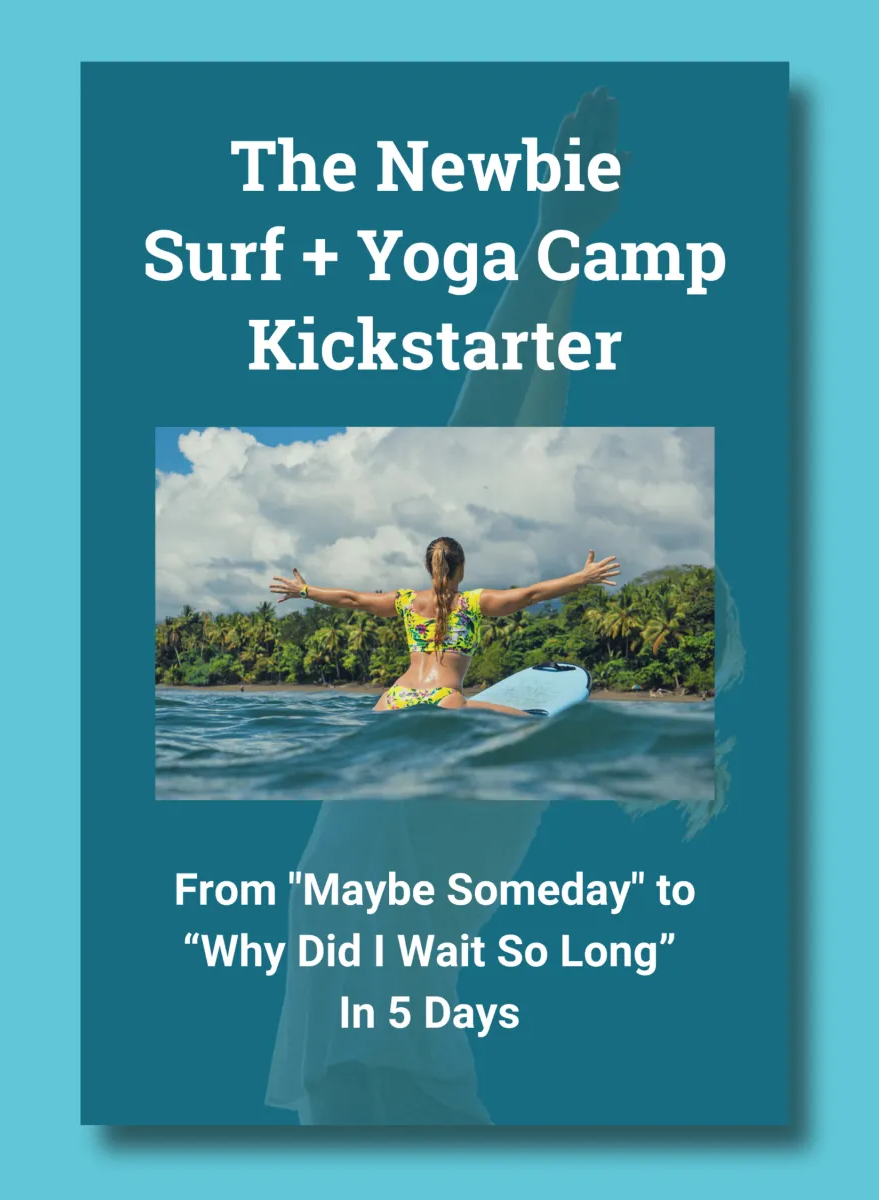
For First-Time Surfers
You Don't Need Experience. You Don't Need Gear. You Just Need This.
Our free 5-day email course that reveals the 5 myths keeping beginners at "I'm not ready" instead of catching their first wave and finding inner peace-and how to overcome them fast.
Change the heading on the Separator tab ->
Search
Ride Waves Like Never Before. Bodysurf.
Get our free email series and learn why bodysurfing will make you a better surfer.
Change the heading on the Separator tab ->
Most Read Blogs
What is the Meaning of Anjali Mudra?
May 27, 2020
Fitness for Surfers: Workouts, Exercises & Training
February 10, 2022
The Best Places to Eat in Uvita, Costa Rica
May 19, 2022
How to Get From SJO to Costa Ballena, Costa Rica
May 31, 2018
Change the heading on the Separator tab ->
Categories
Categories
- Bodysurfing (5)
- Food (8)
- Responsible Business (6)
- Surfing (68)
- Travel (65)
- Yoga (44)
Change the heading on the Separator tab ->
Newsletter
Thanks for subscribing! Please check your email for further instructions.
Change the heading on the Separator tab ->
Follow Us
Bodhi Surf + Yoga
Change the heading on the Separator tab ->
Read more
Pilar’s Ayurveda Exploration: Bringing Ayurveda Home
Words by Pilar
We’re thrilled to have you join us for the fourth of Pilar’s Ayurveda series blogs! We’ve already learned so much about Ayurveda – the ancient science of life. In Pilar’s last three…
Small Ways to Progress Your Surfing: Mastering the Pop Up
Words by Guest Post
Welcome back to our three part series on Small Ways to Progress Your Surfing. In the first blog, we explored: This time around in the second blog of the series, we’ll be…
5 Reasons Why a Surf + Yoga Retreat Should Be Your Next Big Bucket List Adventure
Words by Travis
If you’re reading this, chances are you’re experiencing a little restlessness. You’ve scrolled past the passive beach vacations and you know, deep down, that your next trip needs to be different. It…

